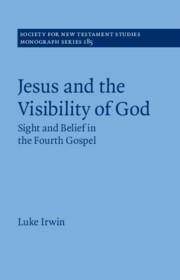Refine search
Actions for selected content:
161 results
28 - Religion and Poetry in Australia
-
-
- Book:
- The Cambridge History of Australian Poetry
- Published online:
- 19 November 2025
- Print publication:
- 11 December 2025, pp 523-537
-
- Chapter
- Export citation

2 Peter
-
- Published online:
- 31 October 2025
- Print publication:
- 20 November 2025
6 - Minority Religious Movements
- from Part II - Religious Traditions
-
- Book:
- Civil Religion and the Renewal of American Politics
- Published online:
- 09 October 2025
- Print publication:
- 23 October 2025, pp 104-132
-
- Chapter
- Export citation

Between Yahwism and Judaism
- Judean Cult and Culture during the Early Hellenistic Period (332–175 BCE)
-
- Published online:
- 18 October 2025
- Print publication:
- 04 December 2025
-
- Element
- Export citation
4 - Between the Rivers Jordan and Chebar
- from Part II - A Sign for This Generation: Reading the Gospels with Origen
-
- Book:
- The Life of Jesus in the Writings of Origen of Alexandria
- Published online:
- 26 September 2025
- Print publication:
- 16 October 2025, pp 71-91
-
- Chapter
- Export citation
Chapter 11 - Religion
- from Part II - Themes and Issues
-
-
- Book:
- The Cambridge Companion to Modernist Theatre
- Published online:
- 28 August 2025
- Print publication:
- 11 September 2025, pp 198-216
-
- Chapter
- Export citation
Chapter 16 - Richard Wagner
- from Part V - Schoenberg’s Others
-
-
- Book:
- Schoenberg in Context
- Published online:
- 04 September 2025
- Print publication:
- 04 September 2025, pp 165-173
-
- Chapter
- Export citation

The Theology of the Letter to the Galatians
-
- Published online:
- 07 August 2025
- Print publication:
- 07 August 2025
5 - Birth Pangs
-
- Book:
- Good Jews
- Published online:
- 19 September 2025
- Print publication:
- 07 August 2025, pp 135-170
-
- Chapter
- Export citation
Chapter 1 - Domestic Religion in Seventeenth- and Eighteenth-Century London
-
- Book:
- Birth, Death, and Domestic Religion in Early Modern London
- Published online:
- 17 July 2025
- Print publication:
- 31 July 2025, pp 28-63
-
- Chapter
- Export citation
Chapter 14 - Religion
- from Part II - Social Contexts
-
-
- Book:
- Sean O'Casey in Context
- Published online:
- 23 June 2025
- Print publication:
- 10 July 2025, pp 150-158
-
- Chapter
- Export citation
The Making of the Rabbi-Scholar in Late Ancient Palestine: Torah Study and Its Others in the Yerushalmi
-
- Journal:
- Harvard Theological Review / Volume 118 / Issue 3 / July 2025
- Published online by Cambridge University Press:
- 22 October 2025, pp. 526-551
- Print publication:
- July 2025
-
- Article
-
- You have access
- Open access
- HTML
- Export citation
5 - Religion and the Global History of Europe
-
-
- Book:
- Globalizing Europe
- Published online:
- 06 March 2025
- Print publication:
- 13 March 2025, pp 66-75
-
- Chapter
- Export citation
Holy day surveys and political attitudes in Israel
-
- Journal:
- Politics and Religion / Volume 18 / Issue 1 / March 2025
- Published online by Cambridge University Press:
- 24 January 2025, pp. 106-129
-
- Article
-
- You have access
- Open access
- HTML
- Export citation
3 - God on Earth
- from Part I - God and Visibility
-
- Book:
- Jesus and the Visibility of God
- Published online:
- 18 January 2025
- Print publication:
- 23 January 2025, pp 89-134
-
- Chapter
- Export citation
Chapter 5 - Prometheus Found
- from Part II
-
- Book:
- Modernism, Aesthetics and Anthropology
- Published online:
- 09 January 2025
- Print publication:
- 23 January 2025, pp 177-219
-
- Chapter
- Export citation
Conclusion
-
- Book:
- Jesus and the Visibility of God
- Published online:
- 18 January 2025
- Print publication:
- 23 January 2025, pp 200-207
-
- Chapter
- Export citation

Jesus and the Visibility of God
- Sight and Belief in the Fourth Gospel
-
- Published online:
- 18 January 2025
- Print publication:
- 23 January 2025
3 - Region and Faith
-
- Book:
- The German Empire, 1871–1918
- Published online:
- 06 December 2024
- Print publication:
- 02 January 2025, pp 91-120
-
- Chapter
- Export citation
Co-produced Religions: Judaism, Christianity, and Islam
-
- Journal:
- Harvard Theological Review / Volume 118 / Issue 1 / January 2025
- Published online by Cambridge University Press:
- 10 March 2025, pp. 159-180
- Print publication:
- January 2025
-
- Article
-
- You have access
- Open access
- HTML
- Export citation
